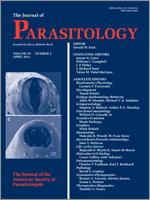The first and third chalimus stages and chalimus adult (previously known as young adult) of Caligus latigenitalis are described based on new material collected from the body surface of a heavily infected wild blackhead seabream Acanthopagrus schlegelii schlegelii from Hiroshima Bay, Japan. The second and fourth chalimus stages of the same species are redescribed. Adults of C. latigenitalis are characterized by possessing 2 stout marginally indented processes at the base of 2 terminal spines at distal exopodal segment of leg 4. The chalimi were identified to stage based on the structure of the frontal filament and the discrete ranges in body length. Sexual dimorphism is first observed at the third chalimus stage in the shape of the distal segment of the antenna. The total number of postnaupliar stages of C. latigenitalis is 6, including 4 semaphoronts, i.e., 1 copepodid stage consisting of 1 infective copepodid and the chalimus copepodid, 4 chalimus stages, and 1 adult stage with 1 chalimus adult and 1 mobile adult. New terminology for the developmental stages of caligid copepods is proposed herein by amending the definition of chalimus as the postnaupliar stages, as well as semaphoronts having a frontal filament for host attachment.
How to translate text using browser tools
1 April 2011
Chalimus Stages of Caligus latigenitalis (Copepoda: Caligidae) Parasitic on Blackhead Seabream from Japanese Waters, with Discussion of Terminology Used for Developmental Stages of Caligids
Ione Madinabeitia,
Kazuya Nagasawa
ACCESS THE FULL ARTICLE

Journal of Parasitology
Vol. 97 • No. 2
April 2011
Vol. 97 • No. 2
April 2011




